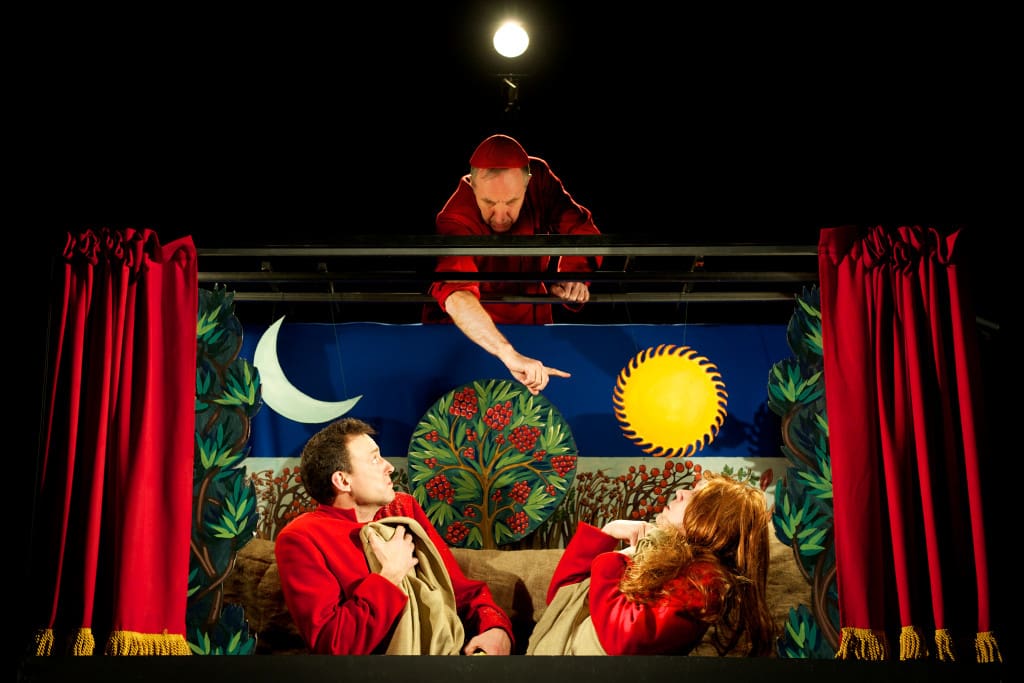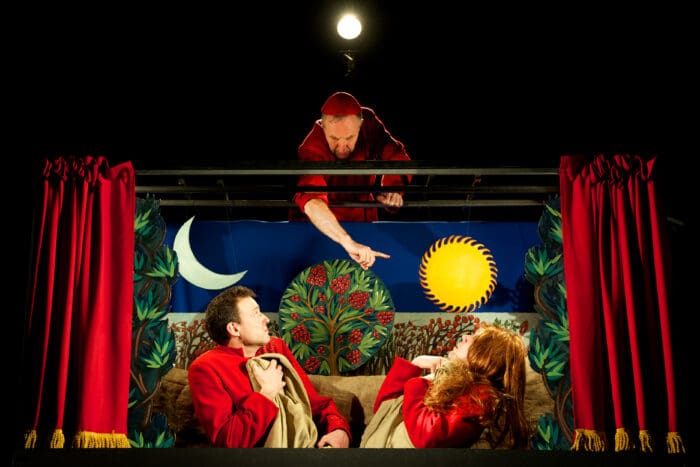 A Catholic Church cardinal comes on to the messy stage at the Harbourfront Studio Theatre. He shuffles around in the near darkness, comes to the front, and suddenly, looks out to the audience, as if noticing them for the first time. Or is it us he notices? For his gaze drifts upwards, and looking, towards the heavens perhaps, he lets out a terrifying scream, and runs from the stage. So begins The Cardinals, with Birmingham’s Stan’s Café, as part of Harbourfront’s WorldStage. The Cardinals was simple, funny, moving, and terrifying. It captured a slice of humanity by reframing our faith and belief as a performance—one that is ongoing today. With striking simplicity, The Cardinals made us laugh at our myths, smile at our poetics, question our gods, and, ultimately rethink the nature of our devotion.
A Catholic Church cardinal comes on to the messy stage at the Harbourfront Studio Theatre. He shuffles around in the near darkness, comes to the front, and suddenly, looks out to the audience, as if noticing them for the first time. Or is it us he notices? For his gaze drifts upwards, and looking, towards the heavens perhaps, he lets out a terrifying scream, and runs from the stage. So begins The Cardinals, with Birmingham’s Stan’s Café, as part of Harbourfront’s WorldStage. The Cardinals was simple, funny, moving, and terrifying. It captured a slice of humanity by reframing our faith and belief as a performance—one that is ongoing today. With striking simplicity, The Cardinals made us laugh at our myths, smile at our poetics, question our gods, and, ultimately rethink the nature of our devotion.
The Cardinals is show within a show about three cardinals performing an abridged version of the bible. Along with their Muslim female stage manager, the three white, red-robed performers start with Adam and Eve, and move to Abraham, Moses, David and Goliath, Jesus, the Crusades, and end today, with the West Bank. Speaking very little, the Cardinals all seem a little disorganized, giving the scenes a clownish, humorous effect. One such example is their depiction of the Lamentation of Christ— the moment after the crucifixion of Jesus where Mary and Mary Magdalena hold his body and morn his death. Much represented in visual art, the cardinals reproduce the scene, evoking a similar pathos as the classical artworks. Two Cardinals hold the other in the iconic tableau, maintaining a goofy austerity. But after a bit, one looks ‘off stage’ (which the audience can see, as their small stage takes up only about half of the full stage): something is clearly wrong, as the two Marys begin to labour under the weight of their comrade. Awkwardly, and to great effect, the one cardinal sneaks his arm off stage, to slowly, and dramatically, close the curtain, the other Mary shaking all the while under the burden of Christ.
However, while the humour alone would be enough, The Cardinals couples it with a political point. For all the three cardinals come off stage. Post-lamentation, frantically searching for the stage manager who was supposed to close the curtain, they find her doing her evening prayers. Thus, the with the meeting of faiths, through the creation of a play, we are left, in this one moment, with many striking images: cardinals dressed as Mary, struggling to hold up Christ; the theatre of Christian put on standstill by Muslim prayer; and finally, when the play starts up again, our main Cardinal, after chastising the stage manager for disappearing, asking her to help him with his veil for the next scene.
Many evocative images such as these find themselves popping up when you least expect it throughout The Cardinals. As such, our actions, and our historical believes are immediately thrown into great relief. The final moments of the play are particularly affective. The friend I brought with me said, when the lights came up, that they had played some trick on us—making us think it was a cute, fun, bit of theatre, and just when we felt safe, they pull out the rug from under us. This isn’t untrue. But their actions and images throughout the play ring of what is theoretically known as the alienation-effect. Coined by theatre director and theorist Bertolt Brecht, The A-effect means to make the familiar strange. With this energy, The Cardinal takes our knowledge of iconic religious stories— familiar even to non-Christians—and turn them on their head. They refuse to their iconic perfect but rather, show us the seams—the backstage, quite literally—of our beliefs. In demonstrating the construction of faith itself, this talented cast offers a critique of religion today, showing the snakes, Davids and Abrahams of everyday life. They show the apocalypse of our time, the one that’s happening now. This is an important play: for believers and non-believers alike. It’s not about religion, but about the stories we tell, and how they become sacrificial lambs, or martyrs for our ideologies.

